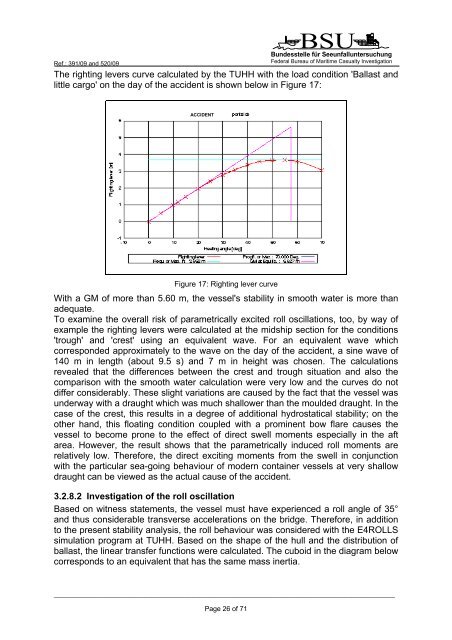SUB-COMMITTEE ON STABILITY AND LOAD LINES AND ON ...
SUB-COMMITTEE ON STABILITY AND LOAD LINES AND ON ...
SUB-COMMITTEE ON STABILITY AND LOAD LINES AND ON ...
Create successful ePaper yourself
Turn your PDF publications into a flip-book with our unique Google optimized e-Paper software.
Ref.: 391/09 and 520/09<br />
BSU<br />
Bundesstelle für Seeunfalluntersuchung<br />
Federal Bureau of Maritime Casualty Investigation<br />
The righting levers curve calculated by the TUHH with the load condition 'Ballast and<br />
little cargo' on the day of the accident is shown below in Figure 17:<br />
ACCIDENT<br />
Figure 17: Righting lever curve<br />
With a GM of more than 5.60 m, the vessel's stability in smooth water is more than<br />
adequate.<br />
To examine the overall risk of parametrically excited roll oscillations, too, by way of<br />
example the righting levers were calculated at the midship section for the conditions<br />
'trough' and 'crest' using an equivalent wave. For an equivalent wave which<br />
corresponded approximately to the wave on the day of the accident, a sine wave of<br />
140 m in length (about 9.5 s) and 7 m in height was chosen. The calculations<br />
revealed that the differences between the crest and trough situation and also the<br />
comparison with the smooth water calculation were very low and the curves do not<br />
differ considerably. These slight variations are caused by the fact that the vessel was<br />
underway with a draught which was much shallower than the moulded draught. In the<br />
case of the crest, this results in a degree of additional hydrostatical stability; on the<br />
other hand, this floating condition coupled with a prominent bow flare causes the<br />
vessel to become prone to the effect of direct swell moments especially in the aft<br />
area. However, the result shows that the parametrically induced roll moments are<br />
relatively low. Therefore, the direct exciting moments from the swell in conjunction<br />
with the particular sea-going behaviour of modern container vessels at very shallow<br />
draught can be viewed as the actual cause of the accident.<br />
3.2.8.2 Investigation of the roll oscillation<br />
Based on witness statements, the vessel must have experienced a roll angle of 35°<br />
and thus considerable transverse accelerations on the bridge. Therefore, in addition<br />
to the present stability analysis, the roll behaviour was considered with the E4ROLLS<br />
simulation program at TUHH. Based on the shape of the hull and the distribution of<br />
ballast, the linear transfer functions were calculated. The cuboid in the diagram below<br />
corresponds to an equivalent that has the same mass inertia.<br />
_____________________________________________________________________________________________________<br />
Page 26 of 71
















